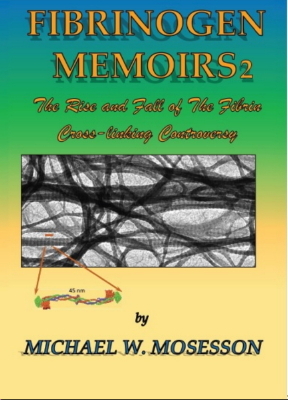
Click Here to Purchase: Fibrinogen Memoirs 2: The Rise and Fall of the Fibrin Cross-linking Controversy by Michael W. Mosesson on IPBooks.net.|
Click Here to Read: Review by James F. Hainfeld, Ph.D., President, NANOPROBES, Inc.
Click Here to Read: Review by Leonid Medved, Ph.D. Professor of Biochemistry and Molecular Biology, Center for Vascular and Inflammatory Diseases, University of Maryland School of Medicine.
Click Here to Read: Kirkus Review of this book.
Why The Author Wrote ‘Fibrinogen Memoirs 2’
Fibrinogen Memoirs: Journeys of a Clot Doctor by Michael Mosesson, contained chapters on the structure, physiology, and metabolism of Fibrinogen and Fibrin. One chapter, ‘Fibrin-The Perfect Bioelastomer’, described a dispute known as ‘The Fibrin Cross-linking Controversy’ that began in 1985 and lasted for twenty years. It reached an apex in 2004 with published debate articles authored by two of the protagonists, after which interest in the controversy declined precipitously, as documented in the narrative up to 2010.
As chronicled in that chapter, the argument concerned the putative arrangement of covalent ‘cross-linked’ bonds within an assembled fibrin polymer. Two mutually exclusive bond arrangements were proffered and termed ‘longitudinal’ and ‘transverse’, respectively. After considering the evidence, Mosesson concluded that these bonds were aligned transversely and that evidence for a longitudinal arrangement was lacking.
As a corollary he also concluded that there was an ineluctable relationship between a transverse bond arrangement and the well-known elastic recovery displayed by a fibrin clot after undergoing deformation by stretching. In stark contrast, longitudinal bond positioning would result instead in inelastic viscous deformation after a stretch without elastic recovery.
Fibrinogen Memoirs 2: The Rise and Fall of the Fibrin Cross-linking Controversy, is a sequel to ‘Fibrin–The Perfect Bioelastomer’ that extends the timeline of controversy decline by an additional ten years (2010 to 2020). During that decade, several investigations were published on the biomechanical properties of fibrin. In all cases, the investigators assumed that cross-linked bonds in their fibrin specimens were arranged longitudinally. By selecting that bond arrangement, they did not account correctly for biomechanical properties such as fibrin elasticity. That unjustified presumption and the erroneous interpretations it engendered about fibrin biomechanical properties, stimulated the Author to write Fibrinogen Memoirs 2.
